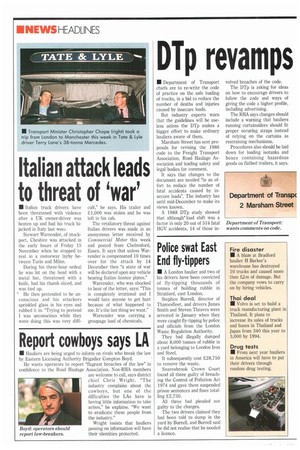Dip revamps :ruck loading code
Page 6

Page 7

If you've noticed an error in this article please click here to report it so we can fix it.
/ Department of Transport chiefs are to re-write the code of practice on the safe loading of trucks, in a bid to reduce the number of deaths and injuries caused by insecure loads.
But industry experts warn that the guidelines will be useless unless the DTp makes a bigger effort to make ordinary hauliers aware of them.
Marsham Street has sent proposals for revising the 1986 code to the Freight Transport Association, Road Haulage Association and leading safety and legal bodies for comment.
It says that changes to the document are needed "in an effort to reduce the number of fatal accidents caused by insecure loads". The industry has until mid-December to make its views known.
A 1988 DTp study showed that although' load shift was a factor in only 20 out of 514 fatal HGV accidents, 14 of those in volved breaches of the code.
The DTp is asking for ideas on how to encourage drivers to follow the code and ways of giving the code a higher profile, including advertising.
The RHA says changes should include a warning that hauliers running curtainsiders should fit proper securing straps instead of relying on the curtains as restraining mechanisms.
Procedures also should be laid down for loading isotanks and boxes containing hazardous goods on flatbed trailers, it says.
Recent accidents involving chemical drums on flatbed trucks have led to calls from safety campaigners for the practice to be banned. But the association admits that publicising the code is the biggest problem: "People are not adhering to it," says technical manager Bob Stacey. "We've got to make them aware of it."
Transport lawayer Jonathan Lawton, however, warns that the code should not be taken too literally by enforcement authorities. In last week's CM he argued that courts often convict hauliers on the basis of whether the code has been adhered to exactly, without looking at circumstances peculiar to the case.
He says that one problem with the code is that it has no statutory force — the law which actually governs load security is Construction and Use Regulation 100.
Lawton also believes that it is too general: "It is written in such a way that it does not give a divine answer to every problem of loading," says Lawton. "There is not necessarily only one way of securing a certain type of load."
The code 'looks as if it has been compiled by a physicist in a laboratory who has never had to go out and deal with a multifaceted load," says Lawton.
In practice, it has to be applied with discretion and intelligence," he concludes.
0 Following the code could reduce insurance premiums, says RHA insurance broker Bain & Clarkson: "it would certainly be a factor taken into account in assessing premiums," says managing director Brian Johnson.




















































































